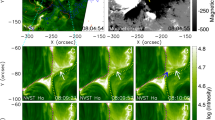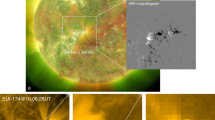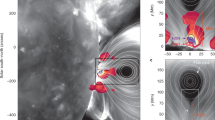Abstract
The ultraviolet emission from the solar transition region is dominated by dynamic, low-lying magnetic loops. The enhanced spatial and temporal resolution of the solar observation satellite Interface Region Imaging Spectrograph (IRIS) has made it possible to study these structures in fine detail. IRIS has observed ‘transient brightenings’ in these loops, associated with strong excess line broadenings1,2 providing important clues to the mechanisms that heat the solar atmosphere. However, the physical origin of the brightenings is debated. The line broadenings have been variously interpreted as signatures of nanoflares3, magneto-hydrodynamic turbulence4, plasmoid instabilities5 and magneto-acoustic shocks6. Here we use IRIS slit-jaw images and spectral data, and the Atmospheric Imaging Assembly of the Solar Dynamics Observatory spacecraft, to show that the brightenings are consistent with magnetic-reconnection-mediated impulsive heating at field-line braiding sites in multi-stranded transition-region loops. The spectroscopic observations present evidence for preferential heating of heavy ions from the transition region and we show that this is consistent with ion cyclotron turbulence caused by strong currents at the reconnection sites. Time-dependent differential emission measure distributions are used to determine the heating frequency7,8,9 and to identify pockets of faintly emitting ‘super-hot’ plasma. The observations we present and the techniques we demonstrate open up a new avenue of diagnostics for reconnection-mediated energy release in solar plasma.
This is a preview of subscription content, access via your institution
Access options
Access Nature and 54 other Nature Portfolio journals
Get Nature+, our best-value online-access subscription
$29.99 / 30 days
cancel any time
Subscribe to this journal
Receive 12 digital issues and online access to articles
$119.00 per year
only $9.92 per issue
Buy this article
- Purchase on Springer Link
- Instant access to full article PDF
Prices may be subject to local taxes which are calculated during checkout





Similar content being viewed by others
Data availability
The observational data used for this study are designated as AR12396 tracking OBS 3860109180 (2015-08-06 15:19:21-16:41:59) and are publicly available for download from the Lockheed Martin Solar and Astrophysics Laboratory at https://iris.lmsal.com/search/. The co-aligned SDO data are also available at the above-mentioned web source. All data that support the findings of this study are available on reasonable request from the corresponding author.
Code availability
Details of the algorithms used to create the main figures, especially the unsharp masking and the calculation of ion cyclotron instability, is available in the Methods. The codes required to reproduce the results of these algorithms are available on reasonable request from the corresponding author. For the calculation of the DEM, an IDL routine written by Hannah and Kontar26 is implemented and can be found at https://github.com/ianan/demreg.
References
De Pontieu, B. et al. The Interface Region Imaging Spectrograph (IRIS). Sol. Phys. 289, 2733–2779 (2014).
Hansteen, V. et al. The unresolved fine structure resolved: IRIS observations of the solar transition region. Science 346, 1255757 (2014).
Testa, P. et al. Evidence of nonthermal particles in coronal loops heated impulsively by nanoflares. Science 346, 1255724 (2014).
De Pontieu, B. et al. On the prevalence of small-scale twist in the solar chromosphere and transition region. Science 346, 1255732 (2014).
Innes, D. E., Guo, L. J., Huang, Y. M. & Bhattacharjee, A. IRIS Si IV line profiles: an indication for the plasmoid instability during small-scale magnetic reconnection on the Sun. Astrophys. J. 813, 86 (2015).
De Pontieu, B., McIntosh, S., Martinez-Sykora, J., Peter, H. & Pereira, T. M. D. Why is non-thermal line broadening of spectral lines in the lower transition region of the Sun independent of spatial resolution? Astrophys. J. Lett. 799, L12 (2015).
Warren, H. P., Brooks, D. H. & Winebarger, A. R. Constraints on the heating of high-temperature active region loops: observations from Hinode and the Solar Dynamics Observatory. Astrophys. J. 734, 90 (2011).
Winebarger, A. R. et al. Defining the ‘blind spot’ of Hinode EIS and XRT temperature measurements. Astrophys. J. Lett. 746, L17 (2012).
Warren, H. P., Winebarger, A. R. & Brooks, D. H. A systematic survey of high-temperature emission in solar active regions. Astrophys. J. 759, 141 (2012).
Cirtain, J. W. et al. Energy release in the solar corona from spatially resolved magnetic braids. Nature 493, 501–503 (2013).
Bradshaw, S. J. & Testa, P. Quantifying the influence of key physical processes on the formation of emission lines observed by IRIS. I. Non-equilibrium ionization and density-dependent rates. Astrophys. J. 872, 123 (2019).
Lemen, J. R. et al. in The Solar Dynamics Observatory (eds Chamberlin, P. et al.) 17–40 (Springer, 2011).
Viall, N. M. & Klimchuk, J. A. Evidence for widespread cooling in an active region observed with the SDO atmospheric imaging assembly. Astrophys. J. 753, 35 (2012).
Lionello, R., Alexander, C. E., Winebarger, A. R., Linker, J. A. & Mikić, Z. Can large time delays observed in light curves of coronal loops be explained in impulsive heating? Astrophys. J. 818, 129 (2016).
Viall, N. M. & Klimchuk, J. A. The transition region response to a coronal nanoflare: forward modeling and observations in SDO/AIA. Astrophys. J. 799, 58 (2015).
Bradshaw, S. J., Klimchuk, J. A. & Reep, J. W. Diagnosing the time-dependence of active region core heating from the emission measure. I. Low-frequency nanoflares. Astrophys. J. 758, 53 (2012).
Barnes, W. T., Cargill, P. J. & Bradshaw, S. J. Inference of heating properties from ‘hot’ non-flaring plasmas in active region cores. I. Single nanoflares. Astrophys. J. 829, 31 (2016).
Cargill, P. J. Active region emission measure distributions and implications for nanoflare heating. Astrophys. J. 784, 49 (2014).
Barnes, W. T., Cargill, P. J. & Bradshaw, S. J. Inference of heating properties from ‘hot’ non-flaring plasmas in active region cores. II. Nanoflare trains. Astrophys. J. 833, 217 (2016).
Cargill, P. J. Some implications of the nanoflare concept. Astrophys. J. 422, 381–393 (1994).
Cargill, P. J. & Klimchuk, J. A. Nanoflare heating of the corona revisited. Astrophys. J. 605, 911 (2004).
Forme, F. R. E., Wahlund, J. E., Opgenoorth, H. J., Persson, M. A. L. & Mishin, E. V. Effects of current driven instabilities on the ion and electron temperatures in the topside ionosphere. J. Atmos. Terr. Phys. 55, 647–666 (1993).
Satyanarayana, P., Chaturvedi, P. K., Keskinen, M. J., Huba, J. D. & Ossakow, S. L. Theory of the current‐driven ion cyclotron instability in the bottomside ionosphere. J. Geophys. Res. Space Phys. 90, 12209–12218 (1985).
Marsch, E., Vocks, C. & Tu, C. Y. On ion-cyclotron-resonance heating of the corona and solar wind. Nonlin. Process. Geophys. 10, 101–112 (2003).
Del Zanna, G., Dere, K. P., Young, P. R., Landi, E. & Mason, H. E. CHIANTI – An atomic database for emission lines. Version 8. Astron. Astrophys. 582, A56 (2015).
Hannah, I. G. & Kontar, E. P. Differential emission measures from the regularized inversion of Hinode and SDO data. Astron. Astrophys. 539, A146 (2012).
Metcalf, T. R., Jiao, L., McClymont, A. N., Canfield, R. C. & Uitenbroek, H. Is the solar chromospheric magnetic field force-free? Astrophys. J. 439, 474–481 (1995).
Ashbourn, J. M. A. & Woods, L. C. Energy transport in the solar transition layer. Proc. Math. Phys. Eng. Sci. 457, 1873–1888 (2001).
Asplund, M., Grevesse, N., Sauval, A. J. & Scott, P. The chemical composition of the Sun. Annu. Rev. Astron. Astrophys. 47, 481–522 (2009).
Acknowledgements
This research was supported by the National Aeronautics and Space Administration (grant number NNX15AF97A). We acknowledge the contributions of the LMSAL/IRIS science team and the NASA/SDO including the AIA and HMI science teams for the observational data. IRIS is a NASA Small Explorer Mission developed and operated by LMSAL with mission operations executed at NASA Ames Research Center and major contributions to downlink communications funded by ESA and the Norwegian Space Centre.
Author information
Authors and Affiliations
Contributions
S.M.B. carried out the project as part of research towards the doctoral degree, including data analysis, interpretation and curation, formal analysis, and developing the necessary methodologies and validation schemes. S.J.B. co-conceived the project and is a co-investigator of the funding grant, undertook formal analysis, and supervised this work as part of S.M.B.’s doctoral thesis at Rice University. A.R.W. co-conceived the project and is the principal investigator of the funding grant. The original draft was written by S.M.B., with revisions by S.J.B. and A.R.W.
Corresponding author
Ethics declarations
Competing interests
The authors declare no competing interests.
Additional information
Peer review information Nature Astronomy thanks the anonymous reviewers for their contribution to the peer review of this work.
Publisher’s note Springer Nature remains neutral with regard to jurisdictional claims in published maps and institutional affiliations.
Extended data
Extended Data Fig. 1 Number density and Sulfur IV Doppler evolution of the candidate loop brightenings seen in the IRIS 1,400 Å channel.
a, b, (Left to Right) IRIS spectrograph slit positions co-spatial with the loop brightening examined at location 1 (a, top row) and location 3 (b, bottom row) of Fig. 1; spatiotemporal evolution of intensity, number density, and the single component S iv Doppler velocity is calculated at each slit position.
Extended Data Fig. 2 DEM-weighted temperature T for the candidate loops.
a, DEM-weighted temperature T for the candidate loops at location 1 (solid) and location 3 (dotted) shown in Fig. 1. b, T for narrower and hot temperature ranges: 107-107.5K and 106.5-107K. c, T for cooler temperature ranges: 106–106.5 K and 105.5–106 K. The onset times of impulsive heating events and their associated brightenings are shown by vertical arrows.
Extended Data Fig. 3 λ-t Diagram of candidate loops.
λ-t diagram of loop brightenings observed at location 1 (a) and location 3 (b) from Fig. 1. Left to right: temporal evolution of IRIS Si iv and Mg iv spectra where intensity is integrated along the x–axis of the IRIS image; temporal evolution of IRIS Si iv and Mg iv spectra where intensity is integrated along both the x and y axes of the IRIS image. In all cases, the integrated intensity is normalized by the pixel array.
Extended Data Fig. 4 Absence of self-absorption lines in candidate loop at location 1.
a, Single pixel array spectra (averaged over y axis) and b, spatially averaged (over x-y area) spectra of candidate loop at location 1 in search of self-absorption lines due to chromospheric reconnection-mediated line broadening. Vertical lines indicate possible self-absorption lines present in this channel such as S I 1,401.515 Å (green) and Fe II 1,401.774 Å, 1,403.101 Å, 1,403.255 Å (red).
Extended Data Fig. 5 Absence of self-absorption lines in candidate loop at location 3.
a, Single pixel array spectra (averaged over y axis) and b, spatially averaged (over x–y area) spectra of candidate loop at location 3 in search of possible self-absorption lines. S I 1,401.515 Å (green) and Fe II 1,401.774 Å, 1,403.101 Å, 1,403.255 Å (red) indicated by vertical lines.
Extended Data Fig. 6 Candidate loop brightenings observed in SDO/AIA channels.
Left to right: candidate loop brightenings at location 1 (top) and location 3 (bottom) discussed in Fig. 1 observed in 6 SDO/AIA channels: 131 Å, 171 Å, 193 Å, 211 Å, 335 Å and 94 Å, respectively.
Supplementary information
Supplementary Information
Supplementary Figs. 1–10, Discussion and Tables 1–3.
Supplementary Video 1
Temporal evolution of the loop at position 1 of Fig. 1.
Supplementary Video 2
Temporal evolution of the loop at position 3 of Fig. 1.
Supplementary Video 3
Existence of super-hot plasma (AIA 131 Å) at the site of reconnection-mediated brightening (IRIS 1,400 Å).
Rights and permissions
About this article
Cite this article
Bahauddin, S.M., Bradshaw, S.J. & Winebarger, A.R. The origin of reconnection-mediated transient brightenings in the solar transition region. Nat Astron 5, 237–245 (2021). https://doi.org/10.1038/s41550-020-01263-2
Received:
Accepted:
Published:
Issue Date:
DOI: https://doi.org/10.1038/s41550-020-01263-2
This article is cited by
-
Transverse oscillations and an energy source in a strongly magnetized sunspot
Nature Astronomy (2023)
-
Generation of laboratory nanoflares from multiple braided plasma loops
Nature Astronomy (2023)
-
A close supermassive black hole binary in Centaurus A?
Astrophysics and Space Science (2022)
-
Deeply learned broadband encoding stochastic hyperspectral imaging
Light: Science & Applications (2021)
-
A New View of the Solar Interface Region from the Interface Region Imaging Spectrograph (IRIS)
Solar Physics (2021)



